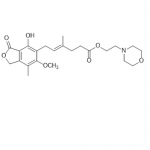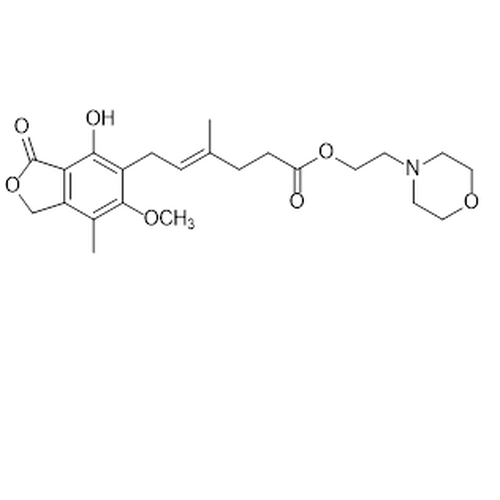| Product Name | Mycophenolate mofetil |
| Description |
Inosine monophosphate dehydrogenase inhibitor |
| Purity | >98% (TLC); NMR (Conforms) |
| CAS No. | 128794-94-5 |
| Molecular Formula | C23H31NO7 |
| Molecular Weight | 433.5 |
| Field of Use | Not for use in humans. Not for use in diagnostics or therapeutics. For in vitro research use only. |
Properties
| Storage Temperature | -20ºC |
| Shipping Temperature | Shipped Ambient |
| Product Type | Inhibitor |
| Solubility | May be dissolved in DMSO (40 mg/ml); or ethanol (4 mg/ml) |
| Source | Synthetic |
| Appearance | White powder |
| SMILES | C/C(=CCc1c(c2c(COC2=O)c(C)c1OC)O)/CCC(=O)OCCN1CCOCC1 |
| InChI | InChI=1S/C23H31NO7/c1-15(5-7-19(25)30-13-10-24-8-11-29-12-9-24)4-6-17-21(26)20-18(14-31-23(20)27)16(2)22(17)28-3/h4,26H,5-14H2,1-3H3/b15-4+ |
| InChIKey | RTGDFNSFWBGLEC-SYZQJQIISA-N |
| Safety Phrases | GHS Classifcation: GHS07 Acute toxicity (oral, dermal, inhalation), category 4, Skin irritation, category 2, Eye irritation, category 2, Skin sensitisation, category 1, Specific Target Organ Toxicity – Single exposure, category 3 AND GHSO9 Hazardous to the aquatic environment, Acute hazard, category1, Chronic hazard, categories 1,2 Hazard statement(s): H302-H400 Precautionary statement(s): P273 |
| Cite This Product | Mycophenolate mofetil (StressMarq Biosciences Inc., Victoria BC CANADA, Catalog # SIH-568) |
Biological Description
| Alternative Names | 6-(1,3-Dihydro-4-hydroxy-6-methoxy-7-methyl-3-oxo-5-isobenzofuranyl)-4-methyl-4-hexenoic acid 2-(4-morpholinyl)ethyl ester |
| Research Areas | Adaptive Immunity, Astrocyte Markers, Autoimmune, B Cells, Cell Markers, Glial Markers, Immunology, Microglia Markers, Neuroscience |
| PubChem ID | 5281078 |
| Scientific Background | Mycophenolate mofetil is an immunosuppressive agent that is metabolized in vivo to mycophenolic acid, which inhibits inosine monophosphate dehydrogenase. This inhibition disrupts guanine nucleotide synthesis, leading to suppression of T cell proliferation and cytokine production. In neuroscience, Mycophenolate mofetil has been shown to reduce microglial and astrocytic activation, thereby mitigating neuroinflammation and neuronal injury. Its ability to modulate immune responses makes it a valuable tool in studying neuroimmune interactions and potential therapeutic strategies for neurodegenerative diseases. |
| References |
1. Allison A.C., and Eugui, E.M. (1996) Clin. Transplant. 10:77. 2. Jonsson C.A., et al., (2002) Cell. Immunol. 216:93. 3. Allison A.C., et al., (1993) Ann. NY Acad. Sci. 696:63. 4. Quemeneur J., et al., (2002) J. Immunol. 169:2747 5. Ebrahimi F., et al., (2012) J. Neuroinflammation 9:89. |



Reviews
There are no reviews yet.